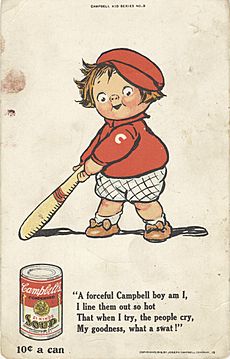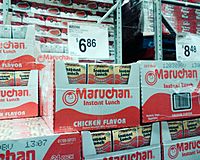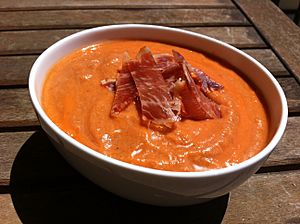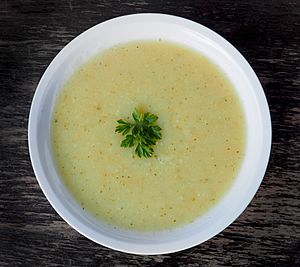Soup facts for kids
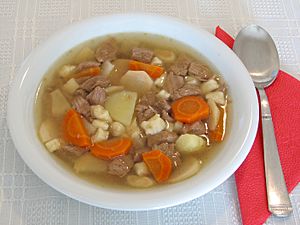
A Hungarian goulash soup
|
|
| Type | Soup |
|---|---|
| Main ingredients | Liquid (stock, juice, water), meat or vegetables or other ingredients |
| Variations | Clear soup, thick soup |
A soup is a type of food. People make soups by boiling different ingredients in water. Then, they put the cooked ingredients into a bowl and eat them. Most soups contain vegetables. You can also add meat to soups. Soups that are thicker, with more meat or vegetables, are often called stews. The liquid part of soup is known as broth.
Soups are usually divided into two main groups: clear soups and thick soups. Clear soups are light, like bouillon or consommé. Thick soups are made thicker with things like starch, cream, or eggs. Common ingredients that make soups thick include rice, lentils, flour, and grains. Many popular soups also have carrots and potatoes.
Contents
History of Soup
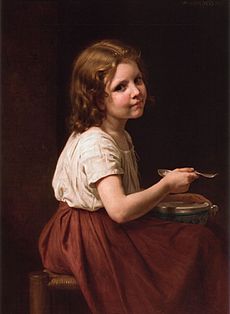
People have been making soup for a very long time, possibly as far back as 20,000 BC. Boiling food became easier after people invented clay pots that could hold water. Before that, people used animal skins or baskets made of bark to boil water. They would heat rocks and drop them into the water to make it hot. This method was used to cook plants like acorns.
The word soup comes from the French word soupe. This word originally meant "bread soaked in broth." It's also related to the word "sop," which is a piece of bread used to soak up liquid from soup or stew.
The word restaurant first appeared in France in the 1500s. It was used for a cheap, strong soup sold by street vendors. This soup was thought to help people feel better when they were tired. In 1765, a person in Paris opened a shop just for these soups. This is how the word restaurant started being used for places where people eat meals.
In the U.S., the first cookbook with soup recipes was printed in 1742. As more immigrants came to the country, different kinds of soups became popular. For example, German immigrants in Pennsylvania were known for their potato soups. In 1794, a French chef opened a restaurant in Boston and became known as the "Prince of Soups."
Ready-Made Soups
Soup became much more popular when canning was invented in the 1800s. Today, you can find many kinds of canned and dried soups in stores.
Canned Soups
Canned soup is easy to prepare. You just heat it in a pan or microwave. Some canned soups are "condensed," meaning you need to add water or milk to them. This allows them to be sold in smaller cans for a lower price. Other canned soups are "ready-to-eat" and don't need any extra liquid.
John Thompson Dorrance, a scientist at the Campbell Soup Company, invented condensed soup in 1897. Since the 1990s, "ready-to-eat" soups in microwaveable bowls have become very popular for quick lunches. Some companies now make soups with less salt for healthier options.
Today, Campbell's Tomato, Cream of Mushroom, and Chicken Noodle soups are very popular in America. People eat billions of bowls of these soups every year. Other well-known soup brands include Progresso.
Dried Soups
Many companies sell dry soup mixes. You just add hot water to them, and sometimes other fresh ingredients. The first dried soups were bouillon cubes, which are solid blocks of dried broth.
Instant noodle soups, like ramen, are very popular in East Asia. They are a cheap and easy meal, needing only hot water. Western-style dried soups include vegetable, chicken, potato, pasta, and cheese flavors.
Types of Soups
In French meals, soup is often the first dish served.
Dessert Soups
Some cultures have sweet soups that are eaten as dessert!
- Chè is a Vietnamese cold dessert soup with sugar and coconut milk. It can have ingredients like taro, cassava, and jackfruit.
- Ginataan is a Filipino soup made with coconut milk, fruits, and tapioca pearls. It can be served hot or cold.
- Shiruko is a Japanese azuki bean soup.
- Tong sui is a general name for Chinese sweet soups.
Fruit Soups
Fruit soups use fruit as their main ingredient. They can be served warm or cold, depending on the recipe and the season.
Cold Soups
Cold soups are served at or below room temperature. They can be sweet or savory. A famous savory cold soup is gazpacho from Spain, which is made from vegetables. Vichyssoise is another cold soup, made from potatoes, leeks, and cream.
Asian Soups
Many East Asian soups use tofu, which is not common in Western soups. Traditional East Asian soups are often clear broths or thickened with starch.
Soups from Around the World
Here are some popular soups from different countries:
- Asopao is a rice soup from Puerto Rico, often made with chicken.
- Ajiaco is a chicken soup from Colombia.
- Avgolemono is a Greek chicken soup with lemon and egg.
- Bánh canh is a Vietnamese noodle soup, like crab or fish cake udon soup.
- Bisque is a thick, creamy, and flavorful soup, often made from pureed shellfish, from France.
- Borscht is a beet-vegetable soup from Eastern Europe.
- Bouillabaisse is a fish soup from Marseille, France.
- Bún bò Huế is a spicy lemongrass-flavored beef noodle soup from Vietnam.
- Caldo verde is a Portuguese soup with minced kale.
- Clam chowder comes in two main types: New England (with potatoes and cream) and Manhattan (with a tomato base).
- Cock-a-leekie soup is a leek and potato soup with chicken stock from Scotland.
- Cullen skink from Scotland is a fish soup with smoked haddock, potatoes, and cream.
- Egg drop soup is a Chinese soup made by adding beaten eggs to boiling broth.
- Ezogelin soup is a traditional Turkish lentil soup.
- Fasolada is a traditional Greek bean soup.
- French onion soup is a clear soup with beef broth and caramelized onions.
- Gazpacho from Spain is a savory soup based on tomato, served cold.
- Goulash is a Hungarian soup with beef, paprika, and onion.
- Gumbo is a traditional Creole soup from the Southern United States.
- Halászlé is a very spicy Hungarian river fish soup with hot paprika.
- Kharcho is a Georgian soup with lamb, rice, and spices.
- Lentil soup is popular in Middle Eastern and Mediterranean cooking.
- Minestrone is an Italian vegetable soup.
- Miso soup is made from fish broth and fermented soy in Japan.
- Noodle soup is a general name for many soups that include noodles.
- Okroshka is a cold soup from Russia.
- Phở is a Vietnamese beef or chicken noodle soup with herbs and spices.
- Sancocho is a chicken soup with vegetables from Latin America.
- Scotch broth is made from mutton or lamb, barley, and root vegetables.
- Shchi is a Russian soup where cabbage is the main ingredient.
- Sinigang from the Philippines is a clear sour soup with tamarind paste and meat or vegetables.
- Snert is a thick pea soup eaten in the Netherlands in winter, often with sausage.
- Solyanka is a Russian soup with pickles, spices, and smoked meat or fish.
- Soto is a traditional Indonesian soup with turmeric and galangal, usually with beef or chicken.
- Soupe aux Pois Jaunes is a traditional Canadian pea soup with yellow peas and often ham.
- Tarator is a Bulgarian cold soup made from yogurt and cucumbers.
- Tomato soup is a common soup with tomatoes as the main ingredient.
- Tom yum is a hot and sour soup with fragrant herbs from Laos and Thailand.
- Ukha is a Russian fish soup.
- Vichyssoise is a French-style cold soup of potatoes, leeks, and cream.
- Waterzooi is a Belgian fish soup.
- Yukgaejang is a Korean spicy beef soup with vegetables.
- Żurek is a Polish sour rye soup with sausages, often served in a bread bowl.
Soup in Sayings
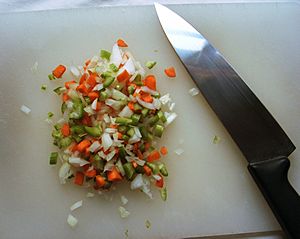
The word soup is used in several English phrases:
- Alphabet soup: This describes many acronyms (like FBI, NASA) used by an organization. It comes from a soup with pasta shaped like letters.
- Duck soup: This means a task that is very easy.
- "From soup to nuts": This means "from beginning to end," because soup is often the first course in a big meal.
- "In the soup": This means being in a bad or difficult situation.
- Soup kitchen: A place that gives free food to people who are homeless or in need.
- Stone soup: A children's story about a clever person who gets villagers to share food by pretending to make soup from a stone.
Gallery
-
A thick pea soup garnished with a tortilla accent
Related pages
Images for kids
See also
 In Spanish: Sopa para niños
In Spanish: Sopa para niños


